Interview with Luboš Kohoutek
Astronomy attracted him after realizing that amateur astronomer could be helpful
in several fields of this Royal science. Finally he graduated in astronomy and
turned his hobby to a lifelong profession. As a student he started with meteor
observation from the roof of a block of flats, at the end he searched the final
phase of red giants under the Southern Cross through the biggest telescopes of
the world. He searched for longtime lost comet, but discovered a new one. The
author of the large scale catalouge of planetary nebulae, discoverer of variable
stars, minor planets and comets,
Luboš Kohoutek.
How and when did you get in touch with astronomy for the first time?
I got interested in astronomy as a 14-year old student. My family fully
supported me in my hobby, my father was a physics teacher. I made a small telescope
from lens, later I received a 55-mm AMAT telescope from my grandmother. I used it
for solar observation for 2 years (by projection method), I counted solar spots
and groups. Astronomy caught my attention because you can be useful in several
fields as an amateur, too. One of those fields was meteor astronomy, I started
to observe meteors (in Brno and later on meteor expeditions).
Astronomy became your passion for good during the years of your secondary school.
So it was a logical step to graduate in astronomy and became a professional
astronomer. Had not it occured to you to choose a different profession at all?
The decision to be a professional astronomer was a continuation of my observations.
As a pupil I dreamt about other career as well, but never after choosing astronomy.
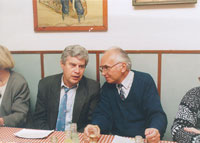 The roof of the block of flats where you lived was your first place for meteor
observations together with your friend Dr. Grygar, who later also became a well
known astronomer. Among the locations you observed meteors from there is also
Bezovec hill near Piešťany, in Slovakia. Was this the origin of your later meteor
expeditions?
The roof of the block of flats where you lived was your first place for meteor
observations together with your friend Dr. Grygar, who later also became a well
known astronomer. Among the locations you observed meteors from there is also
Bezovec hill near Piešťany, in Slovakia. Was this the origin of your later meteor
expeditions?
We made our observations not only at Brno observatory, but also on the roof of the
house where we lived in the nearby park Lužánky. I remember the morning after a
night of observation, when Jiri Grygar attracted attention with camp-bed when he
was returning home. He also used to take me home on his bike after an observation
at the observatory.
Meteor expeditions were organized later in places with the best
viewing conditions in Czechoslovakia, and such places were e.g. Považský Inovec and
Bezovec hill or Mount Lomnický in the High Tatras.
Who were your hero astronomers - people you admired and were inspirations in your youth?
They were prof. Perina, chairman of the Czech Astronomical Society branch in Brno,
Dr. Břetislav Onderlička, head of the Astronomical Institute of the Masaryk
University and later doc. Luboš Perek.
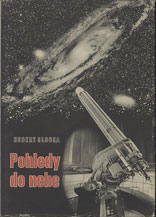 Which book on astronomy was your favourite at that time?
Which book on astronomy was your favourite at that time?
It was "Looking to the sky" (Pohledy do nebe) from Hubert Slouka, which was a
Christmas gift from my parents. This book gave me the basics and also showed how
international astronomy is. It does not matter very much which place on the Earth
you observe the sky from.
Antonín Bečvář, another notable Czech astronomer, and Hubert Slouka, the author
of the above mentioned book were peers. Bečvář was a founder of Skalnate Pleso
Observatory in Slovakia, avid meteor observer, comet discoverer and author of
uniqe Atlas Coeli(Atlas of the Heavens). At the time when you entered the world
of professional astronomy, Bečvář was living in seclusion, working on his star atlases. Have you
ever met him personally?
I highly respected Antonín Bečvář, especially for his hard work and perseverance.
I often used his atlases, but I have never met him personally.
After the initial study of physics at Masaryk University in Brno you went to
Charles University in Prague, where you graduated in astronomy. Then you joined
the Astronomical Institute of the Czechoslovak Academy of Sciences in Prague.
As an amateur you observed Sun, later mostly meteors, but your thesis was devoted
to planetary nebulae. How did you get to this subject?
My interest in meteor astronomy went on during my university studies in Prague,
I wrote my graduation thesis in this field after practice at the Ondřejov Observatory.
I moved to planetary nebulae after the suggestion of my lecturer Luboš Perek. And
later we were co-authors of the Catalogue of galactic planetary nebulae, which
was published in 1967.
This catalog was the result of about ten years of work. How did the idea to create
such a catalogue arise?
The usefulness of such a catalogue arose from the necessity to create order in
this field (especially in the identification of objects) after many years. Our
work was based on visits of Doc. Perek to Mexiko and USA and my own ones to
Tautenburg near Jena (Germany) and also on my first trip to Hamburg-Bergedorf.
The Hamburg-Bergedorf Observatory had the largest Schmidt camera in Europe since
1951 with the aperture of 80 cm. Working with such a telescope was obviously a
dream of every astronomers at that time. How did you manage to start your
cooperation with the Hamburg observatory?
It was arranged by Luboš Perek. My trips to the largest Schmidt telescopes in
Europe, which worked since 1954 in Hamburg, and also to even greater one, built
later in Tautenburg, Germany. My trip to Hamburg in 1964 was also associated with
participation on the International Astronomical Union (IAU) Congress, which was held
there.
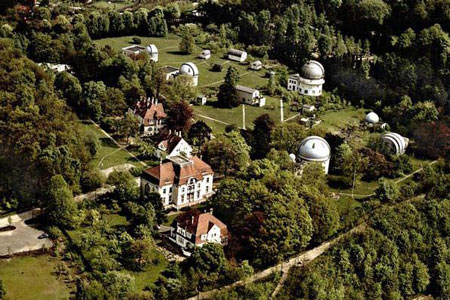
Foto: Hamburger Sternwarte
After the Soviet invasion to Czechoslovakia, your short-term stay turned into a
residence. Was it a tough decision?
I went to Hamburg after the Soviet invasion in August 1968. This short-term and
even legal residence turned into illegal. The decision was very difficult, because
reasons "for" and "against" were pretty balanced. Against illegal residence was
the majority of personal motives, on the contrary there were arguments to stay
based on my professional astronomy perspective, and considering the given political
situation impossibility for long term work at the Academy of Sciences. Fortunately,
the discovery of comet 1973f helped me to legalize my stay in Germany with the
possibility of visiting Czechoslovakia.
Later, the 0,80 m Schmidt camera was moved to Calar Alto Observatory in Spain.
And you followed your research on planetary nebulae from there.
Mainly, there were observational reasons to move the Schmidt telescope to Calar
Alto in southern Spain. Altitude of Calar Alto Observatory (about 2150 m above
sea level) is significantly higher than in Hamburg, the sky is darker there and
the number of clear nights there is considerably greater than in Central Europe.
I was pleased that I could often observe from there and not only with the Schmidt
telescope.
The Hambburg-Bergedorf Observatory remains your home observatory. The European
Southern Observatory (ESO) was founded at Bergedorf too and Germany gave home to
the ESO headquarters. Moreover the first Director General of ESO was Otto Heckmann,
who directed Hamburg-Bergedorf Observatory for 20 years. Thanks to those facts,
you had open doors to La Silla ...
I used to observe at La Silla, Chile even more often than in Calar Alto - the
conditions there are much better there than in Spain. La Silla was and still is
an "astronomical factory", I mean it in a positive content. In 1-2 weeks there
you collect so much raw observation, which is later processed at ESO headquarters
in Garching near Munich, Germany. The Programme Committe decided about the possibilities
to observe at ESO.
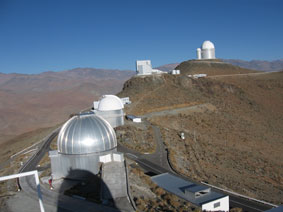
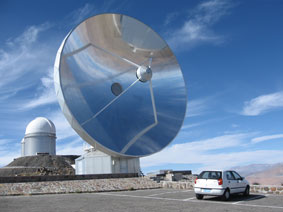
After all you had made observations from La Silla for more than 30 years. How
do you remember your work under the Southern Cross?
I only have nice memories for La Silla Observatory. The life there is, first of
all, about astronomy. The sky is beautiful and dark there - you can see the middle
part of the Milky Way and Magellanic Clouds - it is partly different than the
northern sky I have known from my youth. However, from that nothern sky a part
is also visible. Nevertheless, the living conditions are hard there, observations in
a row during many nights without a break. I used to be there every year because
I had a long-term observation program - searching the variability of central
stars of planetary nebulae. While in 1966, there were 4 known variable central
stars (and 12 suspected of variability), in the new edition of Catalogue of
planetary nebulae from 2001, there are already 124 of them in total (including
also the suspected ones).
Meanwhile, the ESO built a new observatory on the Paranal in the Andes, near the
La Silla, with even larger telescopes (4 telescopes with 8.2 m in diameter of the
primary mirror) and in the Atacama Desert there is a big Radio Astronomy
Observatory (ALMA) under construction. After its compleition 66 radio telescopes
will work there on the mountain plateau at an altitude of 5000 m above sea level.
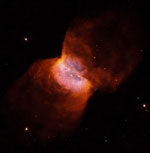
You have summarized the results of your lifelong research of planetary nebulae
in the updated edition of the catalogue, which was published in 2001 as "The
Catalogue of Galactic Planetary Nebulae (version 2000)", this time with a total
of 1510 objects. Its predecessor contained 1036 nebulae.
During your long-term research of planetary nebulae you have discovered over 300
new ones. Do you remember your very first discovery?
I discovered my first planetary nebulae in the Palomar Photographic Atlas (POSS)
after I had started to work at the Astronomical Institute of the Czechoslovak
Academy of Sciences in Prague in 1961. Later I published a larger group of 109 new
nebulae in 1965 based on photographic survey taken with the 80 cm Schmidt camera
(Northern Milky Way survey) after my first visit in Bergedorf.
Have you been caught by usage of the new CCD cameras at your work before your
retirement in the 2001?
CCD cameras are very useful in astronomy. Their arrival caught me in recent years
of my observations at La Silla and at Calar Alto, I worked with them both in the
photometrical and spectroscopical research.
In the 70-s of the 20th century CCD cameras did not exist so astronomers used
photographic plates for observation. Today, the obtained images can be processed
in a few minutes. But you did not have modern computers and software for processing
at that time. How did you process photographs and how much time did you spent on
one plate?
I searched plates under the binocular microscope and compared them with the Palomar
atlas (POSS). The first stage of processing showed whether the observed object
was really new or not. If the result was positive, I checked the recent circulars
of Astronomical Union, whether there had already been any objects reported on
the position where I caught this unknown object. Still, it was necessary to
exclude the possibility that this had been a flaw or a reflex on the plate.
Therefore, it was also advantageous if the plate (due to asteroid search) was
exposed twice: double flaw on a plate could be almost certainly ruled out.
Then with a really new object it was necessary to determine its exact location.
It meant to identify 3-5 stars around with known location. For it I used SAO or
AGK2 star catalogues. This was the basis for measuring rectangular coordinates
(in two positions on plate), from which then spherical coordinates were computed
- for this purpose there was a computer program developed. I guess that I scanned
the plate and compared it with the star atlas for about 1-2 hours, and further
1-2 hours I needed for measuring the positions, including the identification of
comparative stars.
During the years 1967 - 1981 you had discovered, by the procedure described above,
76 asteroids. At all, you had found many more, dozens became "lost" and ultimately
their discovery was credited to others. You devoted to asteroid research only a
few nights a year, was it enough to validate findings and refine their orbits?
Asteroids were my minor research program, and I actually spent only a few nights
on their observation. My biggest project of this program was an attempt to find
the possible remnant of the comet Biela, which disintegrated around the year 1845
(a double image of the comet was still observed in 1852). The most suitable period
for the recovery of the comet Biela was in autumn 1971. I did not find it, but
on seven plates taken by Schmidt camera for this purpose I discovered most of my
asteroids. And the following observations to improve their orbits led in February
/March 1973 to the discovery of two comets, comet 1973e and 1973f. I managed to
observe only several asteroids; I did not have observation time for all sufficiently
bright and visible asteroids. Preliminary orbits for asteroids were calculated by
the recently deceased B. Marsden, Cambridge (USA).
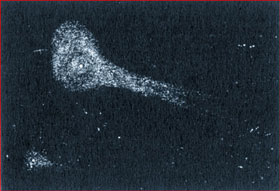
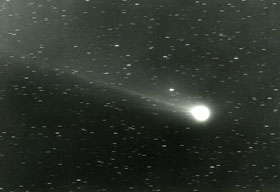
Asteroid (1834), which you discovered exactly one year after the entry of Soviet
troops into Czechoslovakia, was eventually numbered as first among your discoveries
and you named it to honor Czech student Jan Palach. He had burnt himself as to protest
against the former occupation of the country. To give such a name was a tribute
to his courage and also great courage from you. Did not you have any concern that
this could get you into trouble ?
I did not think about the possibility of inconveniences then. I thought only of
Jan Palach, who, by his act, criticised mainly two things: the occupation of
Czechoslovakia, which ended the reform movement known as Prague Spring, and the
apathy of many people in connection with this event.
Planetary nebulae research was your priority, did you have any other projects for
interplanetary matter except your attempt to recover comet Biela?
In addition to various topics around planetary nebulae, I also tried to deal with
projects in the interplanetary matter. My latest work (published in the spring
of 2011) concerns the eta Aquarids meteor shower, which I had the opportunity to
observe using the CCD camera at La Silla Observatory in May 1986, when Halley's
comet had not already been observable.
You are credited with five comet discoveries. The first of them - Kohoutek 1969 b
(C/1969 O1) - you found while you were obtaining spectral image of two novae
in constellation Vulpecula. That was not the common way of comet discovery
(perhaps it was the only one of this kind). Was the comet evident at first sight
or what had it revealed actually?
You are right, the discovery of a comet on spectral image of star field is very unique.
After the elimination of the reflex, it was the movement of the
comet, what revealed it - I photographed that star field twice on that night.
At the beginning of the story of comet 1973f (C/1973 E1) there was your effort to
recover the comet Biela. It did not happen. However, you have found another one,
which was predicted to be a very bright comet by media. Finally, its "performance"
in the sky was a disappointment to the public, although, it brought worldwide
publicity to you. Petr Horálek, young and enthusiastic popularizer of astronomy from Pardubice,
Czech Republic, upon my request, with whom he would like to meet from the "giant"
astronomers, he named you. Although I could not arrange such a meeting, I am glad
that I can pass his question to you:
What did you feel when you noticed your most famous comet of 1973 for the first
time on the photographic plate? Were you sure that it was a new one, still
undiscovered by anyone else? What kind of feeling is it when during your routine
check of the plate a mysterious "fuzzy" object appears probably never ever seen?
And what was the feeling like, when you saw it for the first time with
your own eyes?
I discovered the comet 1973f on the photo plate of the Schmidt camera as a double
hazy cloud around the 16th magnitudes. I determined that it is new by comparison
with the Palomar photographic atlas and after checking that any new object had
not been reported around that location. I also eliminated optical defect on the
plate. It was a double fuzzy, I exposed the star field twice (with interruptions
of several minutes) because I expected there the asteroid 1971 UG. I found that
asteroid on the autumn of 1971 and I wanted to observe it in 1973 to improve its
orbit. I was looking for the comet Biela and I found a number of small asteroids
instead. Although Comet 1973f was new, but only after measuring its position at
the end of March was it possible to calculate its path in the solar system.
Calculation of B. Marsden from USA showed that the comet would be closer to the
Sun than the famous Halley's Comet, and that therefore it c o u l d b e
bright.
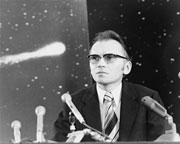 While the comet's path (interim too) is accurate enough to show the approach of
the comet to the Sun and to the Earth, the brightness of the comet can only be
estimated. Our estimation is based on medium of few parameters such as the size
of mass ejection from the nucleus after its approach to the Sun. But the mass
outburst of comet 1973f had been below average (comet had very compact core surface),
so it created only a weak coma and later the faint tail. Maximum brightness of
the comet was thus less than the expected average. It was not a comet of the
century, as it had been particularly predicted by journalists. Considerable time
between its discovery and its greatest brightness brought us few advantages. Most
of the bigger observatories included its observation into their program. It was
also the first comet observed by astronauts from outside the atmosphere (space
station Skylab). Although the appearance of the comet had disappointed the public,
I had a warm feeling when I saw it with my own eyes.
While the comet's path (interim too) is accurate enough to show the approach of
the comet to the Sun and to the Earth, the brightness of the comet can only be
estimated. Our estimation is based on medium of few parameters such as the size
of mass ejection from the nucleus after its approach to the Sun. But the mass
outburst of comet 1973f had been below average (comet had very compact core surface),
so it created only a weak coma and later the faint tail. Maximum brightness of
the comet was thus less than the expected average. It was not a comet of the
century, as it had been particularly predicted by journalists. Considerable time
between its discovery and its greatest brightness brought us few advantages. Most
of the bigger observatories included its observation into their program. It was
also the first comet observed by astronauts from outside the atmosphere (space
station Skylab). Although the appearance of the comet had disappointed the public,
I had a warm feeling when I saw it with my own eyes.
If we mention the name 1973f, it certainly brings a famous comet to our mind.
However you have another discovery with the same label, only two letters "SN"
precede it. Was your discovery of supernova SN 1973f unique, or have you found more?
Supernova SN 1973f was a unique discovery. I found it after comparing the images
around the planetary nebulae (H 4-1). I have not found other supernova.
You are the discoverer of various celestial objects, comets and asteroids
from our nearby interplanetary environment following with novae and planetary
nebulae from considerably distant parts of our galaxy, ending with extragalactic
supernova. Which of so many discoveries do you regard most?
I most appreciate discoveries of objects that I was looking for - and not accidentally
found ones. This means I most esteem new discovered planetary nebulae. But it is
clear that they are not such spectacular objects and that the public probably
admire the Comet 1973f more.
If you just graduated from astronomy, what would you choose as the main field
of your scientific research?
If I currently graduated in astronomy, I would choose the study of exoplanets.
I consider the question of the role of mankind and our Earth in the whole universe
for one of the main tasks of astronomy. Many groups of astronomers are working on
it, they are searching from the Earth's surface (for this purpose you can use
medium size telescopes, in the Czech Republic The Section of variable stars and
planets operate in this field ), and also from different satellites and trying
to increase the number of exoplanets. Few people know that at this time (August 2011)
we known 573 planets orbiting around 481 other stars and that our solar system
is far from unique in the Milky Way - as it was even recently thought.

Do you have a favorite quote on an astronomical topic?
I have not the one and specific astronomical quote. I have been interested in ecology
for the last ten years. It is also related to astronomy and with the fact that
the Earth is part of the universe, that humanity cannot leave it (except of small
groups of astronauts and only temporarily), so we have to value our planet and try
to keep living conditions on it as long as possible. I am convinced that this topic
is much more important for future generations and for the future of humanity than
anything else.
I have also written a book about connection of astronomy and ecology, (Aldebaran
Publishing House, Valasske Mezirici, 2007) and I agree with the statement of Al
Gore (from his book An Inconvenient Truth, 2006), which I would like to quote:
"We are witnessing an unprecedented and severe conflict between our civilization and the Earth."
In your book, among other things you wrote about potential threats to humanity
and warn from them, like Al Gore in his book. Both of you understand that catastrophic
scenarios are happening not only in the movies, but they are a real possibility.
Do you think it is high time for world leading countries and its politicians to
begin to deal seriously with environmental threats?
It is really high time to cope with ecological threats - and this applies not
only to world powers and their politicians. These threats are "creeping" and do
not act immediately, but in terms of long life expectancy of man, such as the
rise of extreme meteorological situations (drought and floods, hurricanes, sea
level rise, melting glaciers). Due to the specific nature of inertia later it
can be too late for the mankind. You cannot just look at the threat as a "vis maior"
as they are caused mainly by human activities. Astronomers have no other choice
but to warn.

